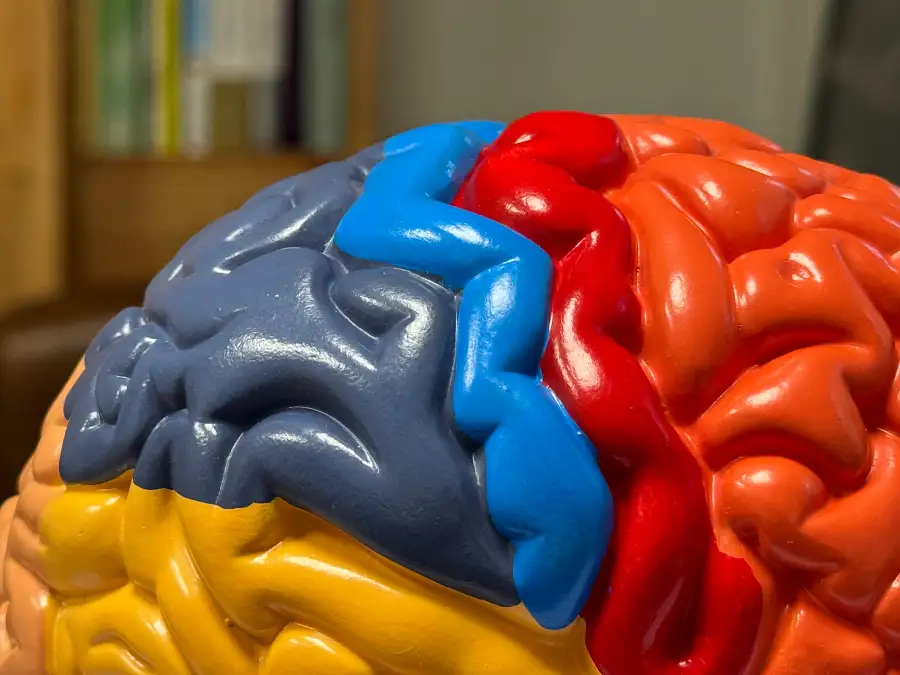Mental Clutter and Illness: The Neuroscience Behind Mind Rooms
What causes the feeling of illness from mental clutter?
Mental clutter activates the hypothalamic-pituitary-adrenal axis, triggering elevated cortisol and norepinephrine levels that manifest as physical symptoms. Research by Icht et al. (2023) demonstrates that cluttering disorders correlate with increased psychosomatic symptoms and depressive states. The prefrontal cortex, responsible for executive function, becomes overwhelmed when processing excessive stimuli from disorganized mental content, leading to cognitive interference and subsequent physical distress. This neurobiological cascade explains why mental disorganization can manifest as somatic complaints.

Human Brain, Scientific Model
What is the Mind Rooms method?
Mind Rooms represents a metacognitive visualization technique that employs neural compartmentalization principles to manage cognitive load. This methodology, developed by Johannes Faupel, utilizes spatial cognition to create mental architecture for thought segregation. The fundamental process involves two neurologically distinct phases: excentration (distributing thoughts into conceptual “rooms”) followed by concentration (focused attention on prioritized cognitive content). This approach harnesses neuroplasticity mechanisms to restructure cognitive patterns that contribute to mental clutter.
Does scientific research support the Mind Rooms approach?
Yes, the Mind Rooms methodology aligns with established research on cognitive organization and psychological well-being. Roster et al. (2016) demonstrated that environmental clutter significantly impairs subjective well-being through disruption of psychological attachment to living spaces. Similarly, Rogers and Hart (2021) identified associations between cluttered environments and diminished mental health metrics. Mind Rooms extends these principles to internal cognitive environments, applying the same neuropsychological frameworks to mental organization that have been validated for physical spaces.
How does Mind Rooms differ from traditional cognitive management techniques?
Unlike conventional mindfulness approaches that often emphasize thought suppression or passive observation, Mind Rooms actively engages spatial memory networks and embodied cognition processes. Traditional techniques frequently neglect the excentration phase that Mind Rooms prioritizes. This distinction is neurologically significant as research by Zakrzewski et al. (2024) highlights how insight deficits in disorganized cognitive states impair executive functioning. Mind Rooms addresses these deficits through structured cognitive architecture that facilitates prefrontal cortex regulation of amygdala activation patterns.
How can Mind Rooms specifically help with working memory limitations?
Mind Rooms directly addresses working memory constraints by reducing cognitive interference through neural compartmentalization. The prefrontal cortex has finite resources for simultaneous information processing. By creating distinct mental spaces for different thought categories, Mind Rooms prevents attentional capture from competing neural signals. This mechanism parallels findings from Mathes and Schmidt (2020) regarding attachment processes and cognitive control. The spatial metaphor employed in Mind Rooms enhances working memory efficiency by leveraging established hippocampal mapping functions normally used for physical navigation.
The relationship between mental organization and stress biomarkers provides neurobiological support for the Mind Rooms approach. Roster and Ferrari (2020) demonstrated that workplace clutter stems from emotional exhaustion and indecision, creating a reciprocal neurobiological relationship. Mind Rooms interrupts this cycle by providing structured cognitive frameworks that reduce hypothalamic-pituitary-adrenal axis activation. This modulates cortisol secretion patterns associated with stress responses, potentially mitigating the psychosomatic symptoms documented by Zukerman et al. (2024) in individuals experiencing cognitive disorganization.
Mental clutter contributes to communication difficulties and subsequent social avoidance behaviors, as documented by Giuffre and Scott (2025). Mind Rooms facilitates improved interpersonal communication by enhancing attentional control and reducing cognitive interference during social interactions. By compartmentalizing extraneous thoughts, individuals can allocate greater neural resources to communication processes, potentially addressing the social challenges associated with cluttered cognitive states. This neural efficiency may counteract the role entrapment and occupational difficulties documented in individuals with disordered cognitive organization.
Research by Swanson and Ferrari (2022) identified age-specific relationships between clutter impact and psychological well-being. The neuroplasticity-based approaches in Mind Rooms appear particularly applicable to older populations experiencing age-related changes in prefrontal cortex function. By providing structured cognitive organization techniques, Mind Rooms may compensate for declining executive function capacity, offering a protective mechanism against the psychological distress associated with cognitive disorganization in aging populations.
References
Giuffre, L., & Scott, K. (2025). Life Impact of Cluttering: The Adult Perspective. American Journal of Speech-Language Pathology, 1-13. https://doi.org/10.1044/2024_AJSLP-24-00262
Icht, M., Zukerman, G., Zigdon, A., & Korn, L. (2023). There is more to cluttering than meets the eye: The prevalence of cluttering and association with psychological well-being indices in an undergraduate sample. International Journal of Language & Communication Disorders. https://doi.org/10.1111/1460-6984.12917
Mathes, B., & Schmidt, N. (2020). An investigation of the impact of social exclusion on attachment to possessions and saving behaviors. Journal of Behavior Therapy and Experimental Psychiatry, 69, 101588. https://doi.org/10.1016/j.jbtep.2020.101588
Rogers, C., & Hart, R. (2021). Home and the extended-self: Exploring associations between clutter and wellbeing. Journal of Environmental Psychology. https://doi.org/10.1016/J.JENVP.2021.101553
Roster, C., & Ferrari, J. (2020). Does Work Stress Lead to Office Clutter, and How? Mediating Influences of Emotional Exhaustion and Indecision. Environment and Behavior, 52, 923-944. https://doi.org/10.1177/0013916518823041
Roster, C., Ferrari, J., & Jurkat, M. (2016). The dark side of home: Assessing possession ‘clutter’ on subjective well-being. Journal of Environmental Psychology, 46, 32-41. https://doi.org/10.1016/J.JENVP.2016.03.003
Swanson, H., & Ferrari, J. (2022). Older Adults and Clutter: Age Differences in Clutter Impact, Psychological Home, and Subjective Well-Being. Behavioral Sciences, 12. https://doi.org/10.3390/bs12050132
Zakrzewski, J., Twamley, E., & Ayers, C. (2024). Insight and Cognitive Performance in Hoarding Disorder. The American Journal of Geriatric Psychiatry. https://doi.org/10.1016/j.jagp.2024.01.133
Zukerman, G., Icht, M., Zigdon, A., & Korn, L. (2024). Self-inefficacy’s impact on well-being indices in students self-identifying with cluttering characteristics. Journal of Communication Disorders, 112, 106469. https://doi.org/10.1016/j.jcomdis.2024.106469
Struggling with sleep?
Finding it hard to focus?
Learn the art of excentration.
